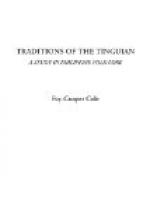Fables
77 The Turtle and the Monkey
There was once a turtle and a monkey who went to make a clearing. The monkey did not work, but the turtle was the one which cleared the land. When one day passed, “Let us go to plant,” said the turtle. They went, and banana was what they went to plant. The turtle planted his in the clearing, but the monkey hung his in a tree when he went to climb. Five days passed. “Let us go to see our planting,” said the turtle. When they arrived where they had planted, the monkey saw that his banana was dry, but that which the turtle had planted bore ripe fruit. When the monkey reached the place where the turtle sat, “I am waiting for you, monkey, for I cannot climb my banana tree.” “Give me fruit, and I will go to climb. My banana which I hung in the tree did not bear fruit,” said the monkey. The turtle laughed and agreed, but when the monkey climbed in the tree he only ate and did not throw down any fruit. “Give me, monkey,” said the turtle. “The thumb still eats,” replied the monkey. Then he pushed a banana up his anus and after that threw it down. The turtle ate it and again asked for fruit. “The little finger still eats,” said the monkey. Then he finished eating the fruit and he slept on the banana tree. The turtle went to search for long sharp shells, and when he had secured them he planted them upright around the tree, and cried, “Bad in the east. Bad in the west.” Then the monkey jumped, and the shells pierced his side so that he died.
The turtle dried his meat and sold it to the other monkeys, and when he had finished selling he went under the house and hid beneath a coconut shell. When all the monkeys had eaten the turtle cried, “They eat their relative.” Then the monkeys heard, but could not see. The turtle called many times until at last they found him beneath the coconut shell. They agreed to kill him with the axe, but the turtle laughed and pointed to the marks on his back. [378] The monkeys believed him when he said he had often been cut by his father and grandfather; so they did not cut, but went to get fire. “You cannot kill me with that. Do you not see that my back




